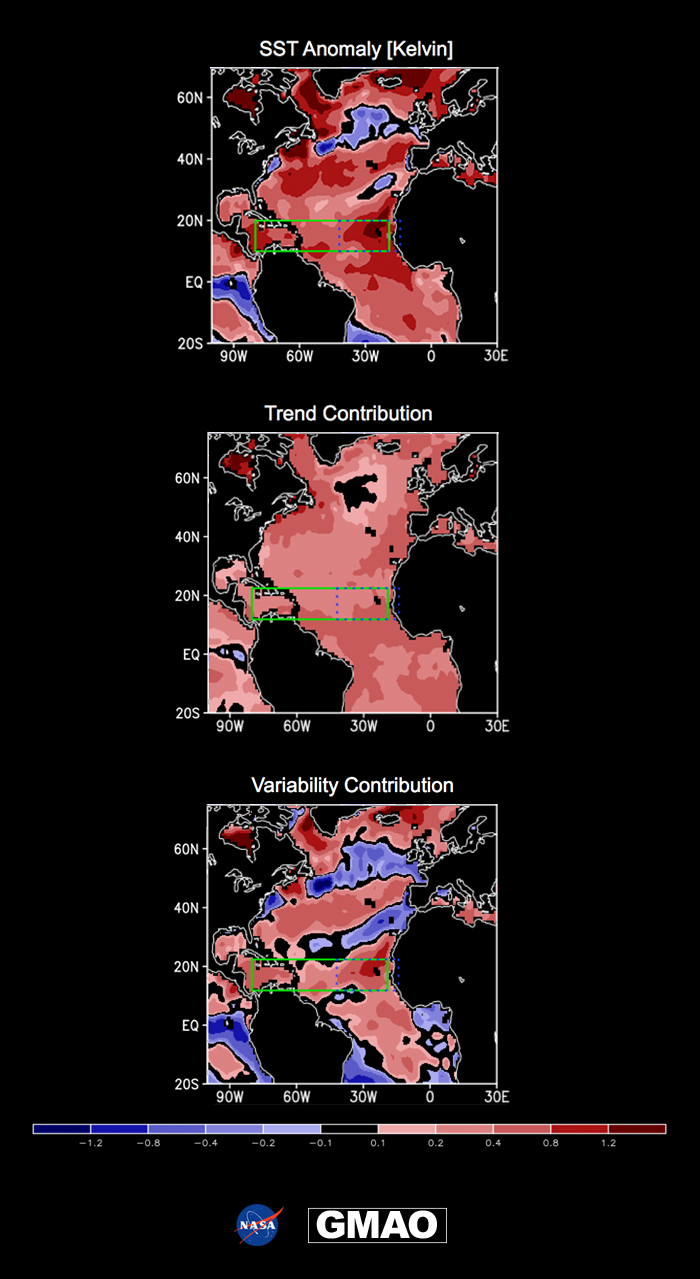The Roles of Climate Change and Climate Variability in the 2017 Atlantic Hurricane Season
The 2017 Atlantic hurricane season was extremely active with six major hurricanes (with two of them reaching Category 5), the third most on record. The accumulated cyclone energy (ACE) in the Atlantic, a measure of tropical cyclone intensity and life cycle for the hurricane season, exceeded 220×104 kn2, which is the fourth largest total value since 1950. The ACE for September 2017 (155.4×104 kn2) is the largest value in a single month in the Atlantic basin.
This study identified the causes of the strong tropical cyclone activity in 2017, with a focus on the long-term linear climate trend and the leading modes of climate variability that impact seasonal tropical cyclone activity over the Atlantic. The focus is on August and September, when almost all the strong tropical cyclone activity occurred. The roles of three well-known modes of climate variability—ENSO, the Atlantic Meridional Mode (AMM), and the North Atlantic Oscillation (NAO)—along with the sea surface temperature (SST) trend associated with a warming climate were examined. The anomalous oceanic and atmospheric structures that occurred in 2017 are compared with those observed during the other recent extreme hurricane years of 2005 and 2010.
One of the key factors suggested was the record-setting warm SST over the eastern Main Development Region (EMDR), where many tropical cyclones developed during active months of August/September, driven primarily by the climate change signal (~0.42°C above the 1901–2017 average) and the AMM that accounted for 80% of the additional (beyond the trend) warming of ~0.54°C. A majority of the tropical disturbances that developed into strong tropical cyclones (Gert, Harvey, Irma, Jose, Lee, and Maria) had their genesis in the EMDR. In addition, the MDR had the third warmest SST on record exceeded only by 2010 and 2005. This was accompanied by record-setting ocean heat content (OHC) over most of the North Atlantic that acted to maintain the warm ocean surface and facilitated the strengthening of the tropical cyclones as they traversed the Atlantic. The larger OHC in 2017 is found to be the combined effect of the trend (most pronounced over the western-central North Atlantic) and the leading modes of climate variability including the AMM that have influences spanning the North Atlantic.
Atmospheric conditions, such as wind shear and sea level pressure (dynamical impact) as well as potential intensity and upper-level outflow temperature (thermodynamical impact), also provided very favorable conditions for tropical cyclone activity over the Atlantic with the maximum over the EMDR in 2017, but these factors were overall less prominent than in 2005 and 2010 across the entire Atlantic basin. ENSO, the NAO, and the AMM together provided the favorable wind shear conditions, while the AMM also produced the very warm ocean and enhanced atmospheric instability. The results overall suggest that unusually warm SST in the EMDR together with the long fetch of the resulting storms in the presence of record-breaking OHC due to both climate change and variability may be key factors in driving the strong tropical cyclone activity in 2017.
Total precipitable water is the depth of water in a column of the atmosphere, if all the water in that column were precipitated as rain.
Brief description of the figure:
The figure above shows a large positive total SST anomaly over the MDR with the maximum in the EMDR. (b) The SST anomaly contributed by the long-term linear trend is positive throughout the Atlantic basin. The anomalies (b) over the MDR and the EMDR are ~0.37 and ~0.42°C. For comparison, the non-trend contributions (c) are ~0.41 and ~0.56°C, respectively. The MDR SST is found to be the third highest in 2017, following 2010 and 2005 (see Lim et al., 2018). The SST anomaly in the EMDR that includes Cape Verde, where several tropical cyclones developed and grew to be major hurricanes during August/September 2017 is the highest on record (~0.96°C).
References:
Full citation of the paper on this study:
Lim, Y.-K., S. D. Schubert, R. Kovach, A. M. Molod, and S. Pawson, 2018: The roles of climate change and climate variability in the 2017 Atlantic hurricane season. Scientific Reports, 8, doi:10.1038/s41598-018-34343-5.


